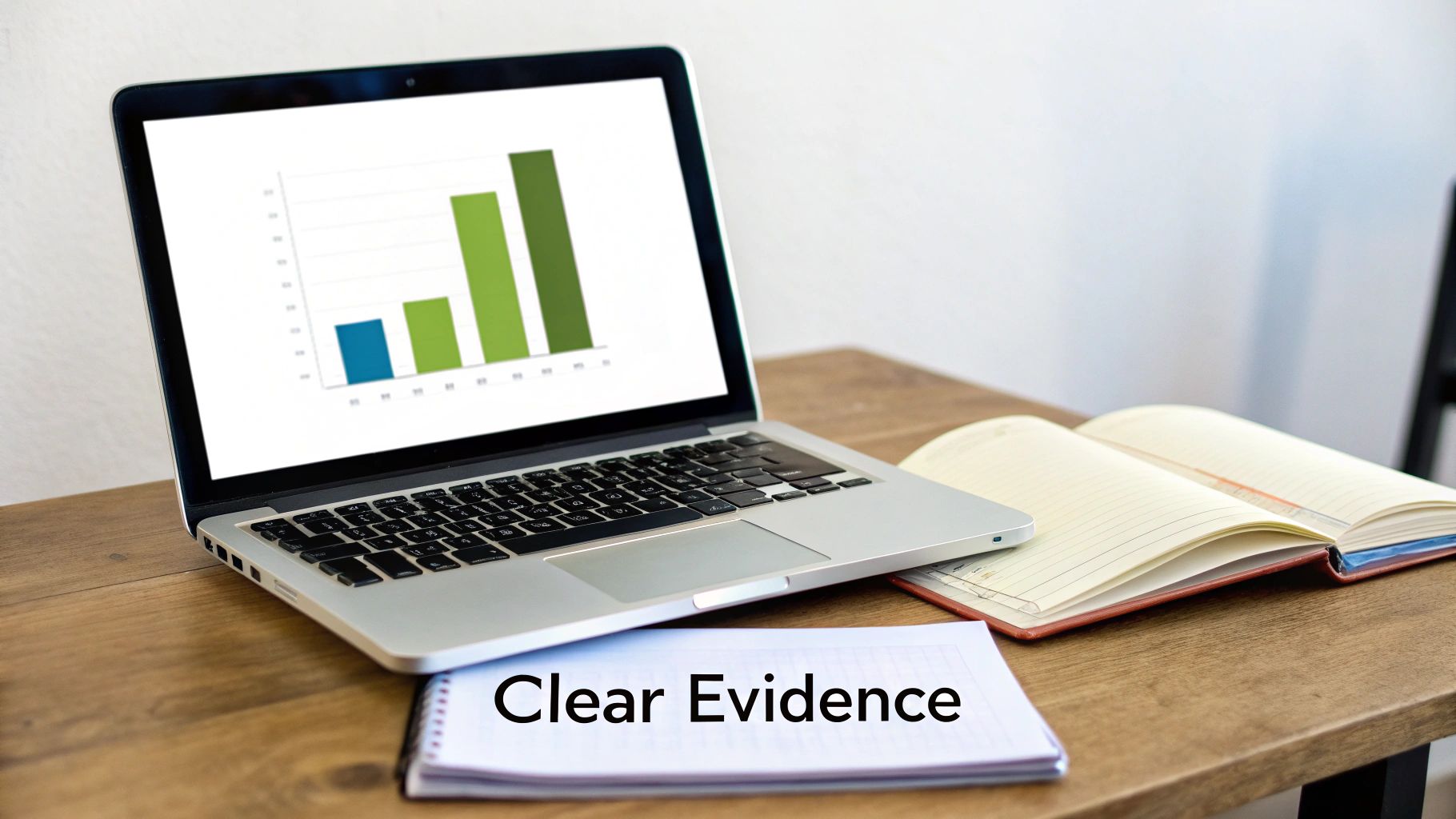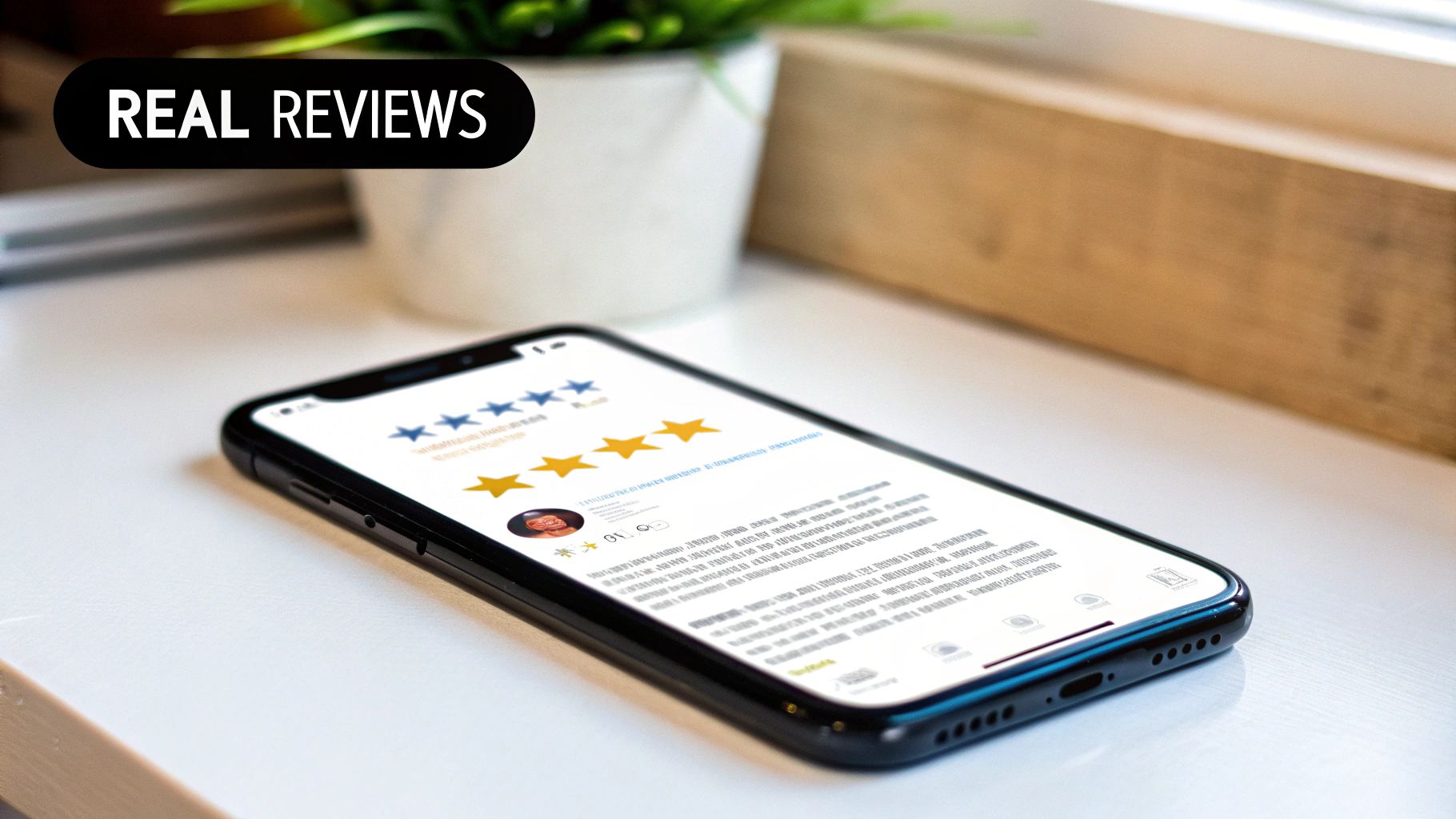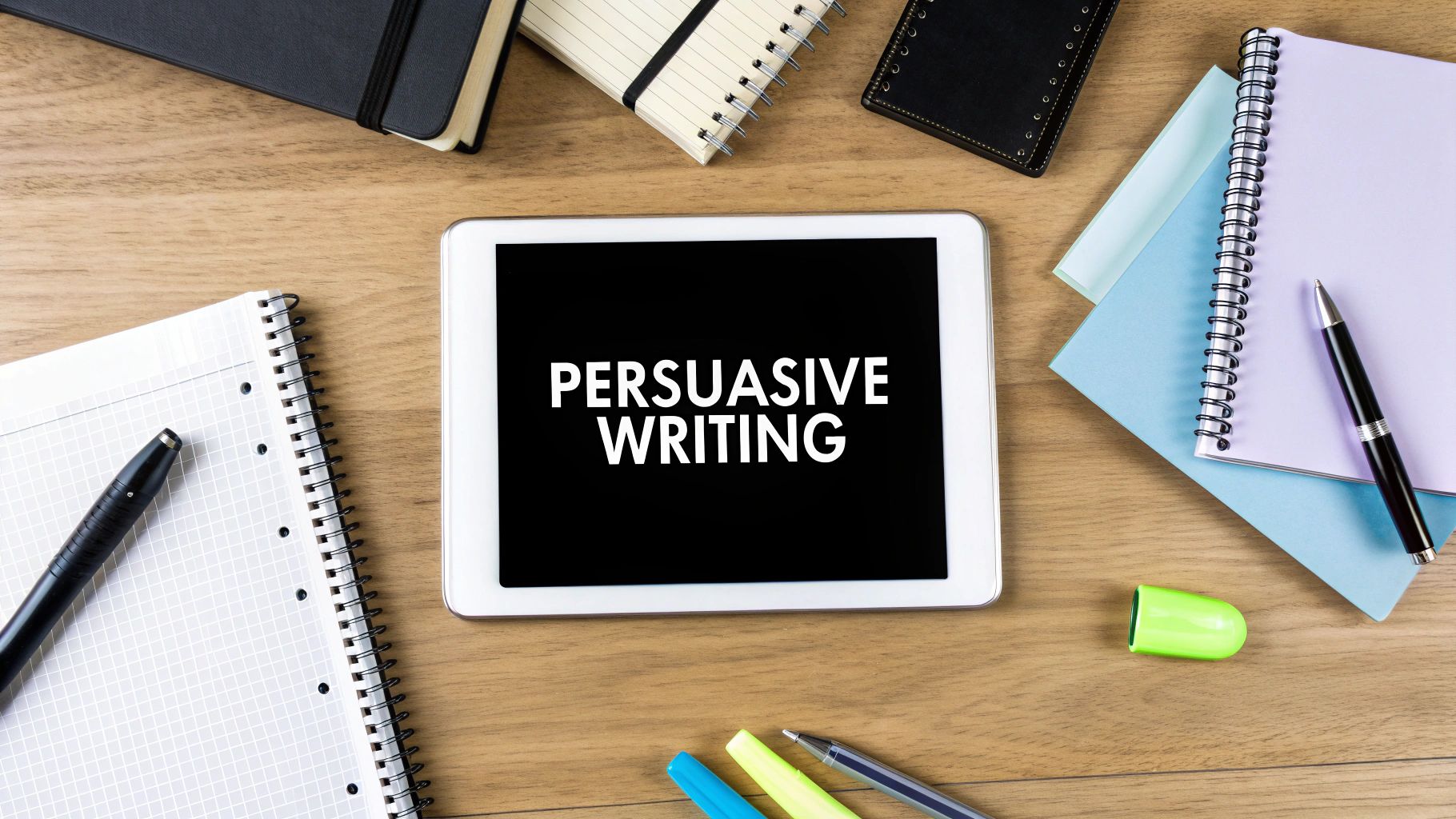Have you ever wondered how some writers can effortlessly capture attention and inspire action? It’s not magic; it’s a mastery of persuasive writing methods. Whether you're drafting a sales email, a compelling cover letter, a social media post, or a fundraising appeal, the ability to persuade is your most valuable asset. The right words can build trust, evoke emotion, present undeniable logic, and guide your reader toward a specific goal.
This skill is crucial in countless scenarios, from professional correspondence to personal projects. For instance, to truly unlock the secrets to compelling communication and achieve your goals, focus on mastering book blurbs that truly sell, turning curiosity into commitment with just a few sentences.
In this comprehensive guide, we'll break down 10 proven persuasive techniques that have stood the test of time, from Aristotle’s rhetorical triangle to modern digital marketing strategies. We’ll move beyond the theory, providing you with actionable tips, real-world examples, and a clear roadmap to implement each method effectively. Get ready to transform your writing from merely informative to truly influential.
1. Ethos (Credibility & Authority)
Ethos is one of the most fundamental persuasive writing methods, focusing on establishing your credibility and authority. When you use ethos, you are essentially telling your audience, "You can trust me on this." It’s about building confidence by demonstrating your expertise, experience, and good character, making your arguments more believable and influential.

This technique works because people naturally trust those they see as experts. Think of a doctor explaining a health issue or a Nobel laureate discussing their field of research. Their inherent authority makes their words carry more weight.
How to Implement Ethos
To effectively build ethos, focus on showcasing your qualifications without sounding arrogant. Your goal is to create a foundation of trust that supports your message.
- State Your Credentials: If you have relevant qualifications, degrees, or years of experience, mention them early. This immediately frames you as a knowledgeable source.
- Cite Reputable Sources: Back up your claims with data, quotes, and references from well-respected experts or institutions. This shows you've done your homework.
- Demonstrate Good Character: Be honest and transparent. Acknowledge any limitations in your knowledge or potential counterarguments. This builds integrity.
For example, when writing a business proposal, mentioning your company’s years of success in the industry establishes credibility. Similarly, building your professional reputation through consistent, high-quality communication is a long-term ethos strategy. You can explore more ways to build this trust through our guide on professional email writing tips. By consistently applying these principles, your persuasive writing will become significantly more effective.
2. Pathos (Emotional Appeal)
Pathos is a powerful persuasive writing method that appeals directly to the audience's emotions. When you use pathos, you aim to create an emotional connection that motivates action, making your readers feel something deeply. By evoking feelings like empathy, joy, fear, or hope, you can create compelling messages that bypass purely logical reasoning and resonate on a personal level.
This technique is effective because human decisions are often driven by emotion. Think of ASPCA campaigns that share stories of rescued animals or Nike's "Just Do It" slogan that inspires a feeling of empowerment. These emotional appeals create a memorable impact that facts and figures alone cannot achieve.
How to Implement Pathos
To use pathos effectively, you must connect with your audience's feelings authentically without being manipulative. Your goal is to build a genuine emotional bridge that supports your argument.
- Tell Authentic Stories: Use real-life narratives or relatable scenarios that allow your audience to see themselves in the situation. This makes the emotional connection feel genuine.
- Use Sensory Language: Describe sights, sounds, smells, and textures to paint a vivid picture in the reader's mind. This helps them experience the emotion rather than just reading about it.
- Align Emotion with Action: Identify the specific emotion you want to evoke and ensure it logically leads to your desired outcome. For example, use hope to inspire donations or urgency to drive sales.
For instance, when writing to a client, sharing a success story from a similar business can evoke feelings of optimism and trust. This is just one of many ways you can apply these principles, and you can discover more in our guide to client communication best practices. By carefully weaving emotional appeals into your writing, you can make your message far more compelling.
3. Logos (Logical Reasoning & Evidence)
Logos is a persuasive writing method that appeals to the audience's intellect by using logic, reason, and factual evidence. When you use logos, you are arguing, "The facts support my conclusion." It’s about building a case with undeniable proof like data, statistics, and sound reasoning, making your arguments difficult to refute and highly compelling.

This technique works because people value evidence-based decision-making. A financial report backed by ROI calculations or a medical recommendation supported by clinical trial results is persuasive because it’s based on objective reality, not just opinion. Logos provides the solid ground your audience needs to feel confident in their agreement.
How to Implement Logos
To effectively use logos, you must present your evidence clearly and structure your arguments logically. The goal is to guide your audience to your conclusion through a rational, step-by-step process.
- Use Credible Data: Support your claims with verifiable statistics, research findings, and case studies from reputable sources. This adds weight to your argument.
- Structure Arguments Logically: Present your information with clear premises leading to an inescapable conclusion. Use cause-and-effect reasoning to connect your points.
- Address Counterarguments: Acknowledge and logically dismantle opposing viewpoints. This shows you have considered all sides and strengthens your position.
For instance, when making a business case for a new software, you would present performance metrics showing increased efficiency and data projecting cost savings. This factual approach is also crucial when you need to learn how to write an appeal letter, where a logical presentation of facts can overturn a decision. By prioritizing clear evidence, your persuasive writing becomes more powerful and convincing.
4. Social Proof & Consensus
Social proof is a powerful persuasive writing method that taps into our natural tendency to follow the actions of others. It operates on the idea that if many people are doing something, it must be the right thing to do. By showing that a product, idea, or behavior is popular and widely accepted, you can persuade your audience to adopt it too.

This technique works because it creates a sense of safety and validation. When people are uncertain, they look to the behavior of others for guidance. Think of an Amazon product page with thousands of five-star reviews or a marketing email that says, "Join over 500,000 satisfied customers." This consensus makes the decision feel less risky and more reliable.
How to Implement Social Proof
To effectively use social proof, you need to showcase authentic and compelling evidence of popularity and satisfaction. Your goal is to make your audience feel like they are joining a large, happy community.
- Use Specific Numbers: Instead of saying "many customers," use concrete data like, "87% of users reported higher productivity." Specifics are more believable.
- Display Testimonials & Reviews: Collect and feature genuine feedback from real customers. Authentic testimonials build trust and provide relatable evidence.
- Showcase Awards & Recognition: Highlight any industry awards, certifications, or positive mentions from reputable sources to demonstrate external validation.
For instance, a software company might display logos of well-known client companies on its homepage. Similarly, showcasing user-generated content on social media leverages community engagement as proof. Mastering this is key to building broad support, and you can discover more in our guide on stakeholder engagement strategies. By integrating these elements, you can make your persuasive writing far more compelling.
5. Scarcity & Urgency
Scarcity and urgency are powerful persuasive writing methods that compel audiences to act immediately. This technique works by highlighting limited availability (scarcity) or a limited timeframe (urgency), creating a fear of missing out (FOMO). By suggesting an opportunity is fleeting, you encourage readers to make a decision quickly rather than procrastinating.
This method is highly effective because people often place a higher value on things that are less available. When something is perceived as rare or exclusive, its desirability increases. Think of the rush for limited-edition products or the lines for Black Friday deals; the principle is the same in writing.
How to Implement Scarcity & Urgency
To leverage this technique effectively, you must create a genuine sense of immediacy without creating distrust. The goal is to motivate, not manipulate, by clearly communicating the constraints of your offer.
- Be Specific and Authentic: Use concrete numbers and deadlines. Instead of saying "limited time only," say "Sale ends in 24 hours" or "Only 3 seats left at this price." Authenticity is key; avoid manufacturing false scarcity, which can damage your credibility.
- Highlight Exclusivity: Frame your offer as an exclusive opportunity for a select group. Phrases like "Early bird pricing" for Kickstarter campaigns or "VIP access" make the audience feel special and more inclined to act.
- Combine with Other Techniques: Scarcity works best when paired with other methods. For example, combine it with social proof by showing how many people have already purchased ("Join 1,000+ happy customers before the offer ends!").
For example, an e-commerce store using a countdown timer for a flash sale creates clear urgency. Similarly, a webinar invitation that states "Only 50 spots available" uses scarcity to drive immediate sign-ups. By mastering these persuasive writing methods, you can significantly boost conversion rates and prompt decisive action.
6. Rhetorical Questions
Rhetorical questions are a classic persuasive writing method where you pose a question not to get an answer, but to stimulate thought and guide your audience toward a specific conclusion. This technique invites readers to engage with your argument on a deeper level, making your point feel like their own realization rather than a direct statement from you.
This approach is powerful because it shifts the dynamic from a one-sided lecture to an internal dialogue. When a reader contemplates a question like, "Are you truly satisfied with the status quo?" they are prompted to reflect on their own experiences, which strengthens the emotional and logical connection to your message.
How to Implement Rhetorical Questions
To use this technique effectively, your questions should be pointed and purposeful, leading your audience down a logical path without being overtly manipulative.
- Prompt Self-Reflection: Frame questions that encourage the reader to consider their own needs or problems. For example, "What if you could achieve your goals without sacrificing your personal time?"
- Challenge Common Assumptions: Use questions to gently dismantle prevailing beliefs or objections. A question like, "Do you want to keep throwing money away on inefficient processes?" forces the reader to reconsider their current approach.
- Guide Towards a Solution: After posing a question, immediately follow up with evidence or introduce your solution. This provides a clear answer to the problem you've highlighted, making your proposal seem like the natural next step.
When used strategically, rhetorical questions can make your arguments more memorable and engaging. Placing them at the beginning of a section can hook the reader, while using them in a conclusion can leave a lasting, thought-provoking impression.
7. Repetition & Reinforcement
Repetition is a powerful persuasive writing method that involves strategically repeating key phrases, ideas, or concepts to strengthen your message. By reinforcing a central point multiple times, you make it more memorable and impactful for your audience. This technique works because familiarity often breeds acceptance; the more someone hears a message, the more likely they are to remember and believe it.
This method is highly effective in driving a message home, ensuring the core argument is not lost. Think of iconic advertising slogans or the chorus of a popular song; their power lies in their repetition. It is a fundamental tool for creating emphasis and building rhythm in your writing, guiding the reader’s focus to what matters most.
How to Implement Repetition & Reinforcement
To use repetition effectively, you must be strategic to avoid sounding monotonous. The goal is to reinforce, not to annoy.
- Vary Your Phrasing: Repeat the core idea but use slightly different wording or sentence structures to keep the content engaging.
- Focus on Key Moments: Use repetition at the beginning and end of your text, or during crucial points of your argument, to maximize its impact.
- Combine with Other Techniques: Pair repetition with emotional appeals (pathos) or strong evidence (logos) to make the reinforced message even more compelling.
For example, in a sales pitch, you might repeat the main benefit of your product, like "saves you time," in the introduction, body, and conclusion. This constant reinforcement helps embed the value proposition in the customer's mind. Martin Luther King Jr.'s "I have a dream" speech is a masterclass in this technique, using repetition to build momentum and emotional weight.
8. Bandwagon Appeal
The bandwagon appeal is a persuasive writing method that taps into our innate desire to belong. It encourages the audience to adopt a certain viewpoint or take a specific action because "everyone else" is doing it. This technique creates a sense of social proof and FOMO (fear of missing out), suggesting that joining the trend is the popular, smart, or correct choice.
This technique is effective because it leverages social pressure and the human need for conformity. When people see that an idea, product, or behavior is widely accepted, they are more likely to adopt it themselves to avoid feeling left out. This is a powerful tool in marketing, politics, and social movements.
How to Implement Bandwagon Appeal
To use the bandwagon appeal effectively and ethically, focus on creating an authentic sense of momentum and community around your message. Your goal is to show that a trend is genuine and valuable, not just to create empty hype.
- Use Specific Numbers: Instead of saying "everyone is using it," provide concrete data like, "Join over 500,000 satisfied customers." This adds credibility to your claim.
- Showcase Testimonials and Social Proof: Feature reviews, case studies, or user-generated content that demonstrates widespread adoption and satisfaction.
- Create a Sense of Urgency: Combine the appeal with time-sensitive language, like "See why this is the top-rated software of the year before the trend passes you by."
For example, a marketing campaign might say, “Millions have already made the switch to our faster internet service.” In a professional context, you could argue for a new strategy by stating, “Top companies in our industry are adopting this technology to boost efficiency.” By highlighting widespread acceptance, you make your proposal seem less risky and more like a proven path to success.
9. Call to Action (CTA)
A Call to Action (CTA) is a powerful persuasive writing method that explicitly tells your audience what to do next. By providing clear, direct instructions, you eliminate ambiguity and guide your reader toward a desired outcome. This technique is designed to convert passive interest into active engagement, making it crucial for any writing meant to produce specific results.
This method works by simplifying the decision-making process. After you've built your case and persuaded your audience, a strong CTA provides the final, essential push. It answers the reader’s subconscious question, "What now?" and gives them a clear, easy path to follow, whether it's making a purchase, signing up, or learning more.
How to Implement a Call to Action
To create an effective CTA, your language must be compelling, clear, and action-oriented. The goal is to motivate the reader to act immediately.
- Use Strong Action Verbs: Start your CTA with powerful verbs like "Download," "Join," "Claim," or "Reserve." These words command attention and imply immediate value.
- Create a Sense of Urgency: Encourage prompt action by using time-sensitive phrases such as "for a limited time," "sign up now," or "get yours today."
- Offer Clear Benefits: Clearly state what the reader will gain by taking action. For instance, "Download your free guide" is more compelling than just "Download."
Effective CTAs are essential in everything from marketing emails to formal proposals. For a deeper dive into how effective writing translates into tangible business results, you can explore the principles of conversion rate optimization. You can also see how CTAs are integrated into professional documents by reviewing these business proposal letter samples. By mastering the CTA, you ensure your persuasive writing leads to measurable action.
10. Anecdotes & Storytelling
Anecdotes and storytelling are persuasive writing methods that leverage personal narratives to create a powerful emotional connection with the audience. Instead of relying solely on data or logic, this technique presents information through engaging stories, making your message more relatable, memorable, and human. A well-told story can transform an abstract concept into a tangible experience.
This approach works because humans are hardwired to respond to narratives. A story about a cancer survivor’s journey is far more moving than a statistic about survival rates. By framing your argument within a story, you invite the reader to see the world from your perspective, building empathy and making them more receptive to your point of view.
How to Implement Anecdotes & Storytelling
To use this method effectively, you must craft stories that are both emotionally resonant and directly relevant to your core message. The goal is to illustrate your point, not just entertain.
- Make it Relatable: Choose stories that reflect the experiences, challenges, or aspirations of your target audience. A founder’s origin story, for example, can explain a company’s mission in a deeply personal way.
- Use Sensory Details: Describe sights, sounds, and feelings to immerse the reader in the narrative. Specific, vivid details make the story feel authentic and memorable.
- Structure Your Narrative: A simple structure with a clear challenge, a turning point, and a resolution gives your story impact. Conclude with a clear takeaway that links back to your main argument.
For example, a marketing email might share a customer success story to demonstrate a product's value. Similarly, a public speaker might open with a personal anecdote to capture the audience's attention and establish a connection. By integrating authentic narratives, you make your persuasive writing more compelling and unforgettable.
Top 10 Persuasive Writing Methods Comparison
| Technique | Implementation complexity | Resource requirements | Expected outcomes | Ideal use cases | Key advantages |
|---|---|---|---|---|---|
| Ethos (Credibility & Authority) | Medium — needs consistent evidence of expertise | Medium — credentials, citations, reputation building | Strong trust, long-term credibility | Academic, medical, expert commentary, controversial topics | Builds trust and reduces skepticism |
| Pathos (Emotional Appeal) | Low–Medium — craft emotional narratives | Low — stories, imagery, testimonials | High engagement and motivation to act | Fundraising, marketing, social causes | Memorable, drives sharing and immediate action |
| Logos (Logical Reasoning & Evidence) | High — structured argumentation and analysis | High — data, research, visuals | Rational persuasion that withstands scrutiny | Scientific, business cases, policy, academic writing | Evidence-based, durable credibility |
| Social Proof & Consensus | Low — display others' approval and metrics | Low–Medium — reviews, user data, endorsements | Increased conversions and reduced perceived risk | E-commerce, product launches, political and social campaigns | Leverages peer influence; easy to measure |
| Scarcity & Urgency | Low — time/availability cues and messaging | Low — timers, stock indicators, messaging | Rapid decision-making and spike in conversions | Flash sales, event ticketing, limited offers | Drives immediate action and FOMO |
| Rhetorical Questions | Low — rhetorical framing in copy | Low — skilled copywriting | Greater audience engagement and reflection | Speeches, opinion pieces, advertising | Prompts thought and makes points memorable |
| Repetition & Reinforcement | Medium — strategic placement and variation | Low–Medium — editorial planning, repetition patterns | Improved retention and message recall | Branding, education, campaigns, speeches | Strengthens recall and emphasis across audiences |
| Bandwagon Appeal | Low — emphasize popularity or trends | Low — adoption stats, testimonials | Faster uptake and social momentum | Trend launches, mass-market campaigns, politics | Reduces decision paralysis; creates social pressure |
| Call to Action (CTA) | Low — clear, directive messaging | Low — design, placement, A/B testing | Measurable conversions and clear next steps | Marketing pages, emails, fundraising, signups | Eliminates ambiguity; increases conversion rates |
| Anecdotes & Storytelling | Medium — craft coherent engaging narratives | Medium — time, authentic stories, editing | Emotional connection and relatability | Brand storytelling, speeches, content marketing | Makes complex ideas relatable and memorable |
Start Writing with Confidence and Impact
You now have a powerful toolkit of ten distinct persuasive writing methods at your disposal. From Aristotle's foundational pillars of Ethos, Pathos, and Logos to modern psychological triggers like Scarcity and Social Proof, these techniques are the building blocks of influential communication. We’ve explored how to build credibility, stir emotions, and present undeniable logic. We've also seen how storytelling, repetition, and a well-placed rhetorical question can transform a simple message into a compelling argument.
The true art of persuasion isn't about using every single one of these methods in a single letter or email. Instead, it's about strategic selection. Think of them as ingredients in a recipe. Your goal is to choose the right combination that best suits your audience, your specific message, and the action you want to inspire. The most effective persuasion feels less like a sales pitch and more like a helpful conversation that guides the reader to a natural conclusion.
Your Path to Persuasive Mastery
Mastering these persuasive writing methods is a journey, not a destination. The key is consistent practice and thoughtful application. Here are your actionable next steps to turn theory into skill:
- Analyze Before You Write: Before drafting your next important email or letter, take five minutes to identify your primary goal and your audience's core needs. Which two or three methods from this list will resonate most powerfully with them? For a sales proposal, you might lean on Logos and Social Proof. For a personal appeal, Pathos and Storytelling will be your strongest allies.
- Practice with Low-Stakes Communication: You don't need a high-pressure situation to hone your skills. Try incorporating a simple anecdote into a team update or using a rhetorical question in a friendly email. Small, consistent efforts build confidence and make these techniques second nature.
- Seek Feedback: Ask a trusted colleague or friend to read your writing. Don't ask them if it's "good." Instead, ask specific questions like, "What was the key takeaway for you?" or "Did this section make you feel more confident in the proposal?" This targeted feedback will reveal whether your chosen methods are having the intended effect.
By consciously applying these strategies, you move from simply sharing information to creating genuine influence. You build bridges between your ideas and your reader's mindset, making it easier for them to say "yes." This ability is invaluable, whether you're aiming for a new job, closing a critical sale, or inspiring your team. Your words have power, and now you have the framework to unlock it with precision and impact.
Ready to put these persuasive writing methods into action but need a head start? The AI Letter Generator can help you craft a compelling first draft in seconds. Simply select a 'persuasive' tone, and our tool will strategically weave these techniques into a polished letter, giving you the perfect foundation to edit and personalize. Create your persuasive letter now with AI Letter Generator.



